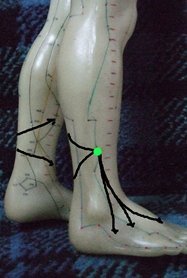Subscribe to the Newsletter
If you are interested in understanding how Traditional Chinese Medicine can improve your life sign up to my newsletter for the latest updates.
The Gallbladder Luo-Connecting Channel pathway shows why Gallbladder 37, its luo point, is so effective.
This page is a bit abstruse if you’re a beginner. It’s not that the words are any more difficult than on other pages, but this is about a subject usually taught some way into acupuncture courses.
So some of the concepts need your familiarity with other ideas in Chinese medicine.
Actually, I did this page, and other luo-connecting channel pages, for a few insistent patients, and for me.
It means I can look up both the channel and its symptoms on my smartphone in case I forget them.
If it helps others, great.
For more information about this type of acupuncture channel, click on luo-connecting channels.
The Gallbladder luo pathway starts at Gallbladder 37.
It then joins up with the primary channel of its partner channel, the Liver. (Click on that to see where it goes.)
It then travels downwards and spreads out in the dorsum of the foot.

All Luo-connecting channels have great influence in maintaining health and mental equilibrium. The following symptoms for the Gallbladder luo channel were described by the ancient Chinese, and mostly arise because of the way it joins up with the Liver primary channel:
Knowing how to treat the Luo-connecting vessels gives acupuncturists great flexibility and understanding of how pain and discomfort accumulate in the body, and how this trapped Qi can be helped.
The luo-connecting points have many attributes, including the ability to stop bleeding and ease pain.
They also have mental potential, helping to calm patients when used correctly for the appropriate syndromes.
If you think about the state someone healthy and active gets into when they have a sudden eye infection or damage in the eye – even a piece of sand/grit in the eye making it impossible to use the eye(s) without great discomfort, meaning they can’t see – you can infer the mental condition here. It’s a feeling of both fullness and deficiency. On the one hand you’ve got something in your eye which is intensely uncomfortable and pressure and rubbing make it worse. This is ‘fullness’. On the other hand, you can’t use the eye to see with, it’s unable to bring you information because it’s not working properly: deficiency. The gallbladder luo channel symptoms describe it beautifully.
This ability to stop bleeding and ease pain applies particularly to the eyes, and makes Gallbladder 37 such a useful point for them.

Stay in Touch!
No spam, only notifications about new articles and updates.

Book a Video consultation if you want to know more about your symptoms

Why You get Nervous Stomach Anxiety and How to Handle It. Acupuncture has great ways to help.
Subscribe to the Newsletter
If you are interested in understanding how Traditional Chinese Medicine can improve your life sign up to my newsletter for the latest updates.
Subscribe to the Newsletter
If you are interested in understanding how Traditional Chinese Medicine can improve your life sign up to my newsletter for the latest updates.
2 Responses
Hey thank you for posting – for whatever it’s worth, I’m reading them!
Thanks Amber, Glad you’re reading about the Gallbladder! If anything’s not clear, let us know, please. Jonathan